Search for local
Approved Contractors and other services
We’re working in partnership with the Home Builders Federation to offer advice on water fittings and fixtures, pipe-laying and plumbing which can help protect stressed water resources.
By following our recommendations, developers can benefit from cost savings, enhanced reputation and be secure in the knowledge they are helping to save water, protect the environment and reduce carbon emissions.
Download our developer advice leaflets:
Download our homeowner advice leaflets:
We use cookies to give you the best possible experience with WaterSafe. Some are essential to provide accurate emergency search results and ensure the website is secure. We also use cookies to help us understand how people use the site and to make improvements. Click "Accept All" to enable recommended settings or click "Manage cookies" to adjust your settings. For more details, see our Cookie Policy.